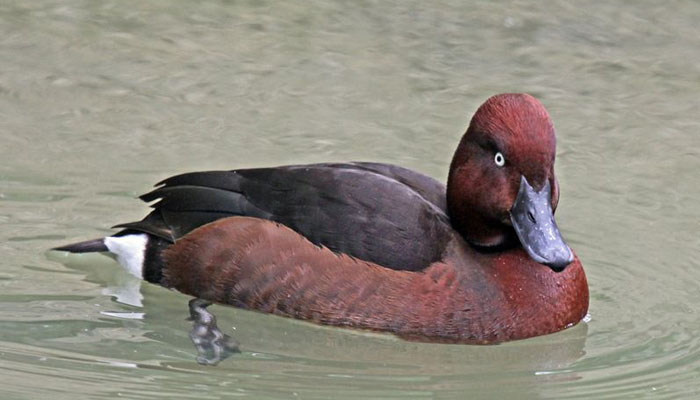
English: Ferruginous Duck, Ferruginous
Pochard
Russian: Белоглазая чернеть
German: Moorente
French: Fuligule nyroca
Mongolian: Ундар шумбуур,
Ундар нүдэн шумбуур
Japanese: メジロガモ (Mejiro-gamo)
Body length: 38-42 cm
Wing span: 60-67 cm
Status: Rare species. According to the IUCN Red List categories and criteria,
the species evaluated as-Vulnerable.
Habitat: Breeds in same habitats as Pochard; less gregarious
(and scarcer); also appears more shy. Rare visitor in Britain autumn-spring. Occurs in the Russian Federation from south of the its European
territories, from Ural to Tyumen. Distributed in Western Europe, Northwestern
Africa, South Asia; Winters in the Mediterranean Sea, Africa, South Somalia,
Southwestern Asia, Myanmar.
Distribution and range in Mongolia: Summer visitor and passage migrant. Fresh water and
saline lakes, ponds, large pools of water with reeds and sedges. Builds nests in
reedbeds. Bulgan River in the Mongol Altai Range, the Darkhad
Depression Boontsagaan Lake, Khar Us, Ogii Lakes in Khuvsgul Aimag, Baga Lake
in Uvs Aimag.
Population and Threats: Population not assessed. Threats: decreasing water levels in the
lakes where the species migrate through or summer, some lakes drying up is have
negative impacts on the species survival chances. In addition, increased number
of motorized boats on the lakes causes distrubances to the species livelihood.
Especially establishment of the Dorgon and Taishir hydroelectric power stations
caused significant drop in water levels in the Zavkhan River, Airag and Zost
Lakes, with reduction in reeds, created unfavorable conditions for this
species. Fishing with nets on the Ogii, Boontsagaan, Khar Khovsgol Lakes gets
this species who dives for their food stuck in those nets causing accidental
deaths. Additional threats are: water pollution, use of reeds, avian flu,
raptors such as Saker and Peregrine Falcons, Whitetailed Eagle. The habitat is
partially included within the NSPAN.
Conservation Measures: Listed as Rare animal in the Annex to the Mongolian Government
Resolution #7 (2012), Included in the Annex II of the Convention on
International Trade on Endangered Species (CITES), the Asia Red Data Book for
birds (2001), and the Mongolian Red Book (1987, 1997).
Further Actions: Study the species reproductive biology, ecology improve the conservation
measures for waterfowl and endangered birds in the NSPAN, conduct monitoring
projects.
Identification: Medium-small, rather short-bodied,
with long bill and neck, and characteristically high forehead and peaked crown.
In flight, very striking, broad, pure white wing-bars running to tip of wing.
On all but some juveniles, white undertail and (separated) white belly patch are
obvious. Beware of some ♀♀ Tufted Ducks with white on undertail (though less
pure and extensive).
- Adult ♂ breeding: Whole plumage deep chestnut
(tinged purplish), darkest on back and palest on flanks, except for white
undertail and belly; narrow black neck-collar
(rarely seen). Eye white.
- Adult ♀: Dark brown with reddish tinge on head. Pure
white undertail, Eye dark. Note head/bill profile, which separates from Tufted
Duck, as do longer and broader white wing-bars in flight.
- Adult ♂ eclipse: Like adult ♀, but tinged more
obviously reddish, and retains white eye.
- Juvenile: Resemble adult ♀ with dark eye, but main
colour more dull brown, and both belly and undertail have less pure and extensive
white patches.